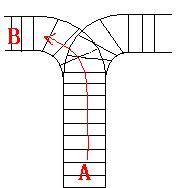(hdu step 8.1.2)Train Problem I(站的基本应用——推断一个序列经过栈后是否可以得到第二个序列)
题目:
Train Problem I |
| Time Limit: 2000/1000 MS (Java/Others) Memory Limit: 65536/32768 K (Java/Others) |
| Total Submission(s): 78 Accepted Submission(s): 60 |
Problem Description As the new term comes, the Ignatius Train Station is very busy nowadays. A lot of student want to get back to school by train(because the trains in the Ignatius Train Station is the fastest all over the world ^v^). But here comes a problem, there is only one railway where all the trains stop. So all the trains come in from one side and get out from the other side. For this problem, if train A gets into the railway first, and then train B gets into the railway before train A leaves, train A can\\\\\\\'t leave until train B leaves. The pictures below figure out the problem. Now the problem for you is, there are at most 9 trains in the station, all the trains has an ID(numbered from 1 to n), the trains get into the railway in an order O1, your task is to determine whether the trains can get out in an order O2.    |
Input The input contains several test cases. Each test case consists of an integer, the number of trains, and two strings, the order of the trains come in:O1, and the order of the trains leave:O2. The input is terminated by the end of file. More details in the Sample Input. |
Output The output contains a string \\\\\\\"No.\\\\\\\" if you can\\\\\\\'t exchange O2 to O1, or you should output a line contains \\\\\\\"Yes.\\\\\\\", and then output your way in exchanging the order(you should output \\\\\\\"in\\\\\\\" for a train getting into the railway, and \\\\\\\"out\\\\\\\" for a train getting out of the railway). Print a line contains \\\\\\\"FINISH\\\\\\\" after each test case. More details in the Sample Output. |
Sample Input 3 123 321 3 123 312 |
Sample Output Yes. in in in out out out FINISH No. FINISH |
Author Ignatius.L |
题目分析:
站的应用,简单题。
代码例如以下:
/*
* b1.cpp
*
* Created on: 2015年3月19日
* Author: Administrator
*/
#include <iostream>
#include <cstdio>
#include <stack>
using namespace std;
const int maxn = 101;
int main(){
int n;//序列的元素个数
string str1;//第一个序列
string str2;//第二个序列
int result[maxn];//用于标记进出栈情况
while(cin >> n >> str1 >> str2){
stack<char> st;
int i = 0;//用于标记第一个序列眼下比較到哪里了
int j = 0;//用于标记第二个序列眼下比較到哪里了
int k;
st.push(str1[0]);//现将第一个序列的第一个元素进栈
result[0] = true;
k = 1;
while(i < n && j < n){//当序列还没有比較完
//假设栈非空 && 栈顶元素和第二个序列眼下比較到的元素同样
if((st.empty() == false) && (st.top() == str2[j]) ){
j++;//将第二个序列的索引向后移动一位
st.pop();//栈顶元素出栈
result[k++] = false;//标记元素的进出情况
}else{
//假设栈已经为空 || 栈顶元素不等于第二个序列中眼下匹配到的元素
if(i == n){//假设第一个元素的全部元素已经入过栈
break;//跳出循环
}
//否则第一个序列中还有元素没有入栈
st.push(str1[++i]);//减少一个序列的下一个元素入展
result[k++] = true;//标记进出情况
}
}
//输出结果
if(i == n){
cout << "No." << endl;
}else{
cout << "Yes." << endl;
for(i = 0 ; i < k ; ++i){
if(result[i] == true){
cout << "in" << endl;
}else{
cout << "out" << endl;
}
}
}
cout << "FINISH" << endl;
}
return 0;
}





